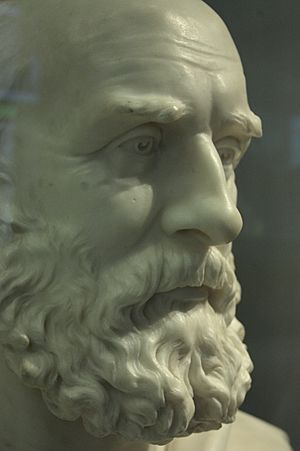David Napier (marine engineer) facts for kids
David Napier (1790–1869) was a clever Scottish engineer who designed and built parts for early steamships. He played a big role in making steam travel on water much better and faster. His work helped improve how ships were built and how they moved across the water.
Contents
Who Was David Napier?
David Napier was born on November 10, 1790. He grew up in a family of engineers. His father had a workshop in a place called Camlachie in Scotland. This is where David first learned about engineering.
Early Work and the Comet
David Napier started working in his father's business. In 1812, he built the boiler for a famous ship called the Comet. This was one of the very first steamships in Europe. After his father, David took over the workshop. He quickly became known as one of the best builders of marine engines in Scotland. Marine engines are the powerful machines that make ships move.
Moving to Lancefield Quay
In 1821, David Napier moved his workshop to Lancefield Quay. This was a new location right on the Clyde River. His cousin, Robert Napier, took over the old workshop in Camlachie. At Lancefield, David Napier started building entire ships, not just their engines.
The Aglaia and Iron Ships
In 1827, David Napier built a ship called the Aglaia. This ship was special because it was one of the world's first steamships to use iron in its design. The Aglaia had an iron bottom, which was a new idea at the time. It was built to carry passengers on Loch Eck as part of a new travel route. This route helped people get to Inveraray more easily. The Aglaia later sailed on the Clyde River. The very first iron steamer was the Aaron Manby, built in 1821.
Challenges and Improvements
David Napier faced some tough times with his ship designs. Between 1835 and 1838, there were serious problems with some of his ship boilers. Boilers are like giant kettles that create steam to power the ship's engine.
Boiler Safety Concerns
Two of these incidents involved a ship called the Victoria of Hull. This ship had boiler problems twice in 1838 while sailing on the River Thames. These events showed how important it was to make boilers safer. David Napier worked hard to improve his designs and make sure his engines were reliable. These challenges helped engineers learn more about safety in steamship design.
Later Life and Legacy
In 1839, David Napier bought a shipyard in London, on the River Thames at Millwall. His two sons helped him run this yard. David continued to experiment and find new ways to make steamboats better.
The Great Eastern Connection
In 1854, Napier's shipyard was sold to Messrs J Scott Russell. This company used the yard to build one of the most famous ships ever, the Great Eastern. This huge ship was a marvel of engineering for its time.
David Napier's Sons
David Napier had several children who also became important in engineering and other fields.
- His youngest son, Robert D. Napier (1821–1885), became a well-known marine engineer. He created many inventions and wrote important papers about his research.
- Another son, Francis Napier (died 1875), worked as a surveyor in Sydney. He was also part of an important exploration trip along the Northern Territory coast of Australia in 1867–1868.
David Napier passed away on November 23, 1869. He is remembered as a pioneer who helped shape the early days of steam travel on water.


